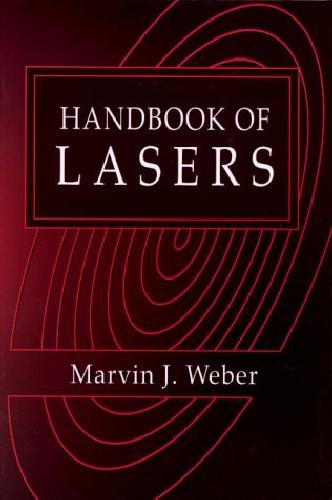Weber M.J.
Table of contents :
Hanbook of Lasers……Page 0
Periodic Table Of The Elements……Page 2
Preface……Page 4
General Reading……Page 7
The Author……Page 8
Advisory Board……Page 9
Contributors……Page 10
Contents……Page 16
Section 1: Solid State Lasers……Page 20
1.0 Introduction……Page 21
1.1.1 Introduction……Page 23
1.1.2 Host Crystals Used for Transition Metal Laser Ions……Page 37
1.1.3 Host Crystals Used for Lanthanide Laser Ions……Page 38
1.1.4 Tables of Transition Metal Ion Lasers……Page 47
1.1.5 Tables of Divalent Lanthanide Lasers……Page 54
1.1.6 Tables of Trivalent Lanthanide Ion Lasers……Page 55
1.1.7 Actinide Ion Lasers……Page 118
1.1.9 Self-Frequency-Doubled Lasers……Page 119
1.1.10 Commercial Crystalline Transition Metal Ion Lasers……Page 121
1.1.11 Commercial Crystalline Lanthanide Ion Lasers……Page 122
1.1.12 References……Page 124
1.2.1 Introduction……Page 181
1.2.2 Tables of Glass Lasers……Page 187
1.2.3 Glass Amplifiers……Page 201
1.2.4 Commercial Glass Lasers……Page 202
1.2.5 References……Page 203
1.3.1 Introduction……Page 215
1.3.2 Dye Doped Organic Lasers……Page 216
1.3.3 Silica and Silica-Gel Dye Lasers……Page 225
1.3.5 Dye Doped Glass Lasers……Page 229
1.3.8 Commercial Solid State Dye Laser……Page 230
1.3.9 References……Page 231
1.4.1 Introduction……Page 236
1.4.2 Centers and Crystals for Color Center Lasers……Page 238
1.4.3 Table of Color Center Lasers……Page 240
1.4.5 References……Page 245
1.5.1 Introduction……Page 249
1.5.2 II-VI Compound Lasers……Page 253
1.5.3 Mercury II-VI Compound Lasers……Page 255
1.5.4 III-V Compound Lasers……Page 256
1.5.5 III-V Compound Antimonide Lasers……Page 260
1.5.6 Nitride Lasers……Page 261
1.5.7 Lead IV-VI Compound Lasers……Page 262
1.5.8 Germanium-Silicon Intervalence Band Lasers……Page 263
1.5.9 Other Semiconductor Lasers……Page 264
1.5.10 Quantum Cascade and Intersubband Lasers……Page 265
1.5.11 Vertical Cavity Lasers……Page 267
1.5.12 Commercial Semiconductor Lasers……Page 269
1.5.13 References……Page 270
1.6.1 Introduction……Page 290
1.6.2 Pure Polymer Lasers……Page 291
1.6.3 Dye Doped Polymer Lasers……Page 295
1.6.4 Rare Earth Doped Polymer Lasers……Page 305
1.7 SOLID STATE EXCIMER LASERS……Page 306
1.8.1 Introduction……Page 307
1.8.2 Crystalline Raman Lasers……Page 308
1.8.3 Fiber Raman Lasers and Amplifiers……Page 311
1.8.4 Fiber Soliton Lasers……Page 312
1.8.5 Fiber Brillouin Lasers……Page 313
1.8.6 References……Page 314
Section 2: Liquid Lasers……Page 319
2.1.1 Introduction……Page 320
2.1.2 Chemical Nomenclature……Page 322
2.1.3 Tables of Liquid Organic Dye Lasers……Page 325
2.1.5 Dye Laser Tuning Curves……Page 375
2.1.6 References……Page 382
2.2.2 Chelate Lasers……Page 390
2.2.3 Aprotic Liquid Lasers……Page 396
2.3 LIQUID POLYMER LASERS……Page 399
2.4 LIQUID EXCIMER LASERS……Page 400
Section 3: Gas Lasers……Page 401
3.0 Introduction……Page 402
3.1.1 Introduction……Page 404
3.1.2 Tables of Neutral Atom Gas Lasers……Page 406
3.1.2.1 Group IA Lasers……Page 407
3.1.2.2 Group IB Lasers……Page 410
3.1.2.3 Group IIA Lasers……Page 412
3.1.2.4 Group IIB Lasers……Page 414
3.1.2.5 Group IIIA Lasers……Page 417
3.1.2.6 Group IVA Lasers……Page 420
3.1.2.7 Group IVB Lasers……Page 423
3.1.2.8 Group VA Lasers……Page 424
3.1.2.9 VB Lasers……Page 428
3.1.2.10 Group VIA Lasers……Page 429
3.1.2.11 Group VII Lasers……Page 435
3.1.2.13 Group VIII Lasers……Page 442
3.1.2.14 Group VIIIA Lasers……Page 446
3.2.1 Introduction……Page 473
3.2.2 Energy Level Diagrams……Page 475
3.2.3 Tables of Ionized Gas Lasers……Page 490
3.2.3.2 Group IB Lasers……Page 491
3.2.3.3 Group IIA Lasers……Page 496
3.2.3.4 Group IIB Lasers……Page 498
3.2.3.5 Group IIIA Lasers……Page 502
3.2.3.6 Group IVA Lasers……Page 504
3.2.3.7 Group VA Lasers……Page 506
3.2.3.8 Group VIA Lasers……Page 510
3.2.3.9 Group VIB Lasers……Page 517
3.2.3.10 Group VII Lasers……Page 518
3.2.3.11 Group VIII Lasers……Page 523
3.2.3.12 Group VIIIA Lasers……Page 524
3.3.1.1 Introduction……Page 540
3.3.1.2 Diatomic Electronic Transition Lasers……Page 542
3.3.1.3 Triatomic Electronic Transition Lasers……Page 616
3.3.1.4 Polyatomic Electronic Transition Lasers……Page 617
3.3.2.1 Introduction……Page 618
3.3.2.2 Diatomic Vibrational Transition Lasers……Page 620
3.3.2.3 Triatomic Vibrational Transition Lasers……Page 663
3.3.2.4 Four-Atom Vibrational Transition Lasers……Page 715
3.3.2.5 Five-Atom Vibrational Transition Lasers……Page 724
3.3.2.6 Six-Atom Vibrational Transition Lasers……Page 729
3.3.2.7 Seven-Atom Vibrational Transition Lasers……Page 730
3.4.1 Introduction……Page 731
3.4.2 Tables of Atomic Far Infrared Gas Lasers……Page 733
3.4.3 Tables of Far Infrared and Millimeter Wave Gas Lasers……Page 735
3.5 COMMERCIAL GAS LASERS……Page 853
3.6 COMMENTS……Page 856
3.7 REFERENCES……Page 1038
Section 4: Other Lasers……Page 1118
4.1.1 Introduction……Page 1119
4.1.2 Lasing Transitions of H-Like Ions……Page 1122
4.1.3 Lasing Transitions of Li-Like Ions……Page 1123
4.1.5 Lasing Transitions of Ne-Like Ions……Page 1124
4.1.7 Lasing Transitions of Ni-Like Ions……Page 1128
4.1.8 Lasing Transitions of Pd-Like Ions……Page 1130
4.1.9 References……Page 1131
4.2.1 Introduction……Page 1135
4.2.2 Short Wavelength Free Electron Lasers……Page 1137
4.2.3 Long Wavelength Free Electron Lasers……Page 1141
4.3.1 Introduction……Page 1145
4.3.2 Reactor Pumped Lasers……Page 1147
4.3.4 References……Page 1149
4.4 NATURAL LASERS……Page 1152
4.5 INVERSIONLESS LASERS……Page 1155
4.6 AMPLIFICATION OF CORE-VALENCE LUMINESCENCE……Page 1158
Appendices……Page 1160
APPENDIX I LASER SAFETY……Page 1161
APPENDIX II Acronyms, Abbreviations, Initialisms, and Common Names for Types of Lasers, Laser Materials, Laser Structures and Operating Configurations, and Systems Involving Lasers……Page 1169
APPENDIX III Electron Configurations of Neutral Atoms in the Ground State……Page 1182
APPENDIX IV Fundamental Physical Constants……Page 1185
Conversion factors for Spectroscopists……Page 1186

Reviews
There are no reviews yet.